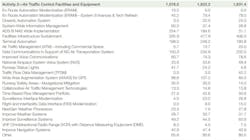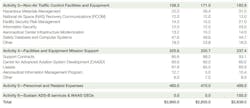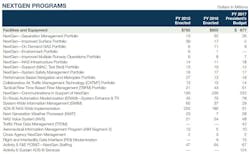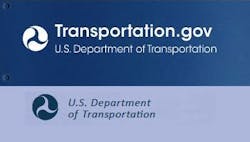President’s budget targeted at hardware/software modernization, moving to satellite-based ATC
“NextGen is improving the safety, capacity, and efficiency of air travel by replacing ground-based radar surveillance with a modern satellite-based system," Foxx says. "NextGen also capitalizes on the latest in aircraft technology.
"The needs of the NAS and the aviation community it serves continue to evolve. New users such as unmanned aircraft systems (UAS) and commercial space vehicles are entering our Nation’s airspace in increasing numbers, and will need to be accommodated in the NAS of the future,” Foxx continues.
“This request is a responsible and necessary investment in critical capital infrastructure and the ongoing deployment of NextGen technologies," Foxx says. "The proposal will advance the delivery of NextGen benefits to the user community while decreasing FAA’s overall Budget by transforming the airport financing system.
"This transformation focuses Federal grant dollars on airports that need it most, while providing for increased investment opportunity in airport infrastructure. The budget also allows FAA to safely integrate new entrants such as unmanned vehicles and increasing numbers of commercial space launches into the NAS,” Foxx says.
Major program highlights of the FAA’s budget request include:
Operations:
The FY 2017 President’s Budget is requesting $10.0 billion for the operation, maintenance, communications, and logistical support of the air traffic control and air navigation systems. This represents an increase of 1 percent above the FY 2016 enacted level to accommodate uncontrollable pay and inflationary increases, transition from F&E of maintenance costs for new equipment, and discretionary increases. Offsetting these increases are $47 million in cost savings achieved through the Contract Weather program, Lean Maintenance, and other administrative efficiencies.
Included in the Operations request are the following:
► Air Traffic Organization (ATO): $7.5 billion is requested to provide safe, secure, and cost-effective air traffic services to commercial and private aviation. This includes $27 million to transition projects from the capital program to Operations and $2.8 million to support the Lean Maintenance and Revalidation Program (LMRP), which analyzes cost and performance data, maintenance activities, and sustainment and support requirements. The Budget assumes a total of $37 million in savings for ATO including $6.5 million in savings from LMRP.
► Aviation Safety Oversight (AVS): $1.3 billion is requested to ensure the continued safety of the air transportation system. This includes $2.9 million and 9 FTEs for increases in staffing for safety inspectors, engineers, and other safety critical staff for integration of Unmanned Aircraft Systems (UAS) and $500 thousand for increasing data capabilities within the Hazard Tracking System for the collection of safety information within the Hazard Tracking Tool. The staffing request is aligned with the forecasted staffing requirements included in the AVS Workforce Plan.
► Commercial Space Transportation (AST): $19.8 million is requested to ensure the protection of the public, property, and national security of the United States during commercial launch and reentry activities. This includes an increase of $723 thousand and 7 new FTEs to enhance mission critical operational staffing to support launch and reentry integration as well as an increased demand in license and permit determinations, certifications, and other authorizations required by this growing industry.
► Finance & Management (AFN): $771 million is requested to provide centralized management and delivery of core services to FAA’s lines of business and staff offices. Within this amount, an increase of $4.0 million and 2 new FTEs are requested for Information System Security (ISS) to improve FAA’s cybersecurity detection, response, and recovery capabilities.
► Security and Hazardous Materials Safety (ASH): $107 million is requested to protect FAA’s critical infrastructure, deliver emergency operations and contingency planning, and ensure the safe transportation of hazardous materials in air commerce. As a result of the comprehensive security review conducted after the Chicago Air Route Traffic Control Center (ZAU) fire incident on September 26, 2014, FAA is requesting an increase of $1.7 million and 10 FTEs to implement facility and personnel security recommendations for FAA’s critical operational facilities. The request also includes an increase of $1.8 million and 2 FTEs for the FAA’s Insider Threat Detection and Mitigation Program (ITDMP) to deter, detect, and mitigate potential employee threats to national security and/or aviation safety and provide a turnkey solution to integrate network monitoring capability.
► Transition from F&E to Operations: $37.3 million is requested to transition operating and maintenance costs of new systems from F&E to Operations. Systems transitioning in FY 2017 include System-Wide Information Management (SWIM) at $10.9 million, System Approach for Safety Oversight (SASO) at $7.6 million, Integrated Display System Replacement (IDSR) at $4.2 million, Runway Status Lights (RWSL) at $1.4 million, and other programs totaling $13 million. This funding is necessary for continued operation and maintenance of the systems at sites where they have been deployed. Facilities & Equipment (F&E): The FY 2017 President’s Budget is requesting $2.8 billion to enable FAA to meet the challenge of both maintaining the capacity and safety of the current National Airspace while continuing its comprehensive system modernization and transformation.
► Within these funds, the FY 2017 President’s Budget requests $877 million for NextGen capital investments, an increase of $22 million above FY 2016. This will enable FAA to continue its ongoing modernization efforts.
Examples of specific projects include:
Performance Based Navigation: $18 million is requested to optimize the use of airspace and procedures in the metroplex areas.
En Route Automation Modernization System Enhancements and Technology Refresh: $78 million is requested to provide enhancements to the automation system that are based upon user experience as well as to refresh technology that was installed over 10 years ago. Improvements in the efficiency and effectiveness of air traffic management and reduction in operational errors are the expected outcomes of this investment.
Automatic Dependent Surveillance Broadcast: $31 million is requested for the continued implementation of satellite-based surveillance capabilities in the Continental U.S., in the Gulf of Mexico, and Alaska. This will provide a more complete picture of airspace conditions and more accurate position data that will result in increased capacity, fewer delays, and more optimal routing for aircraft. $124 million will provide the funding for the satellite subscription services.
Air-to-Ground Data Communications: $232 million is requested for data communications, to deploy a text-based data communication system in both the Terminal and En Route domains. This program will enable air traffic controller productivity improvements, and will permit capacity growth without requisite cost growth associated with equipment, maintenance, and labor.
System-Wide Information Management (SWIM): $29 million is requested to continue the implementation of an information management and data sharing system for improved data sharing for FAA’s internal and external stakeholders. This program will provide policies and standards to support data management, secure its integrity, and control its access and use.
Time Based Flow Management: $51 million is requested to maximize traffic flow and airport usage by improving flow management into and out of the busy metropolitan airspaces and corresponding airports. Operations will achieve maximum throughput while facilitating efficient arrival and departure.
Traffic Flow Data Management (TFDM): $42 million is requested to provide an integrated approach to maximize the efficient collection, distribution, and update of data supporting flight information in the terminal area (airspace around an airport and airport surface data). The TFDM program will automate the manual flight data processes to enable enhanced data sharing between the Tower Air Traffic Control, the En Route Air Traffic Control, Approach Control, Traffic Flow Management, and Flight/Airline Operations domains.
Flight and Interfacility Data Interface (FIDI) Modernization: $15 million is requested to modernize the exchange of flight data between the En Route Automation System and other Terminal and Oceanic systems. The program will enable continued air traffic control operations in the event of a facility outage.
► The remainder of the investment, $2.0 billion, will be in legacy areas to sustain current systems, including maintaining aging infrastructure, power systems, information technology, navigational aids, communications, surveillance, and weather systems.
Examples of specific projects include:
Air Traffic Control Facilities Strategic Sustainment Plan: $483 million is requested for an effort that will advance the state of good repair for FAA infrastructure facilities. This undertaking will target funding toward a portfolio of programs that include FAA Air Route Traffic Control Centers (ARTCCs), Air Traffic Control Facilities (ATCTs), and Terminal Radar Approach Control Facilities (TRACONs). Electrical Power Systems, Unmanned Infrastructure Facilities, Employee Protection, Environmental Programs at FAA Facilities, and temporary facilities used for responses to emergency and heavy air traffic situations are also included. The funding under this portfolio of programs will improve and maintain the facility condition index ratings at FAA facilities that provide the backbone for the NAS systems and functionality.
Terminal Automation Modernization/Replacement: $173 million is requested to modernize and standardize the automation systems at the FAA’s Terminal Radar Approach Control (TRACON) facilities and their associated Airport Traffic Control Towers (ATCT) throughout the NAS.
The FY 2017 President’s Budget is requesting $167.5 million to support the continuation of work in both NextGen and other research areas such as environmental and safety research including fire research, propulsion and fuel systems, unmanned aircraft, advanced materials research, and weather research. This is an increase of 0.9 percent over the FY 2016 enacted level. Highlighted research programs include:
► NextGen Alternative Fuels for General Aviation: $5.8 million is requested to support continued efforts and industry partnerships to transition from current aviation 100 low lead fuel to an unleaded replacement fuel that will have the least impact on the General Aviation Fleet.
► Unmanned Aircraft System Research: $8.4 million is requested to support research on UAS technologies which directly impact the safety of the national airspace. As detailed in the UAS Roadmap for Integration and the interagency UAS Integration Comprehensive Plan, FAA’s 2017 research will be focused on sense and avoid, control and communications, systems safety criteria, modeling and simulation requirements, and research that will support the safe, efficient, and timely integration of UAS in the NAS.
► NextGen—Environmental Research—Aircraft Technologies, Fuels, and Metrics: $26.2 million is requested to achieve NextGen goals of increased mobility by reducing environmental impacts of aviation in absolute terms, including those relating to community noise, air quality and global climate change. The program is focused on maturing aircraft technologies that can reduce aircraft noise, emissions that degrade air quality, greenhouse gas emissions, and energy use and advancing alternative jet fuels.
► Commercial Space Transportation Safety: $3 million is requested to continue to investigate improvements for the safe integration of commercial space operations into the NAS, with an emphasis on reducing the amount of airspace affected by launch and reentry operations, responding more effectively to operational contingencies, and more expeditiously releasing affected airspace to other NAS users. Advanced safety assessment methods will be furthered by refining approaches to estimate failure probabilities for reusable vehicles and improving public safety assessments during off-nominal incidents. Advanced vehicle safety technology and methodologies will be studied to isolate priority areas of concern for repetitive use of spaceflight vehicles and identify draft recommended practices for autonomous flight safety systems. Human space flight safety and physiologic factors studies will determine draft recommended practices for crew human factors for suborbital winged commercial spaceflight vehicles.
The FY 2017 President’s Budget is requesting $2.9 billion obligation limitation for AIP, a decrease of $450 million from the FY 2016 enacted level.
► To assist those airports that are in most critical need, the Budget proposes focusing Federal grants to support smaller commercial and general aviation airports that do not have access to additional revenue or other outside sources of capital.
► At the same time, the Budget proposes to increase the Passenger Facility Charge (PFC) limit from $4.50 to $8.00 for all commercial service airports and eliminate guaranteed AIP entitlement funding for large hub airports, giving them greater flexibility to generate their own revenue.
► The combination of these two proposed changes to the AIP and PFC programs will allow for higher levels of infrastructure funding at our Nation’s airports.
A new Federal Aviation Administration Authorization Act
The FAA’s current authorization expires 31 March 2016. Officials in the Department of Transportation (DOT) reveal the following core principles, which provide a framework for deliberations about the FAA’s next authorization:► Maintain the safest aviation system in the world;
► Modernize the FAA’s air traffic control system;
► Secure appropriate funding for the Nation’s airports;
► Enable the integration of new users into the National Airspace System;
► Foster an FAA culture of innovation and efficiency;
► Allow the better alignment of resources with the needs of the National Airspace System;
► Strengthen the Department of Transportation’s global leadership in aviation;
► Ensure a strong consumer protection regime for the flying public; and,
► Foster competition, new entry, and connectivity to the National Air Transportation System.
“These principles are intended to guide reauthorization to improve safety, make the National Airspace System more efficient, and improve service for air travelers and other stakeholders,” says U.S. Secretary of Transportation Anthony Foxx. “These principles are also based on the need for stable and adequate funding for core air traffic control operations, NextGen investments, and efficient recapitalization of aging facilities,” Foxx explains. “The FAA is still recovering from the budget cuts imposed by sequestration in FY 2013 and the resulting impact to controller staffing. These principles are a critical part of avoiding such disruptions in the future.”








